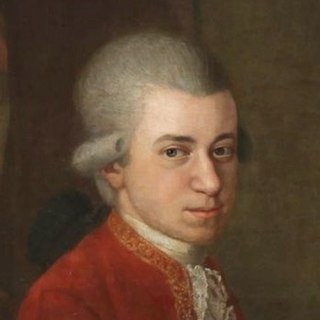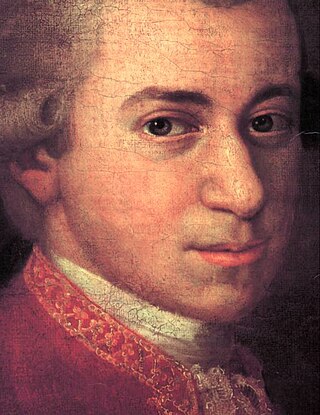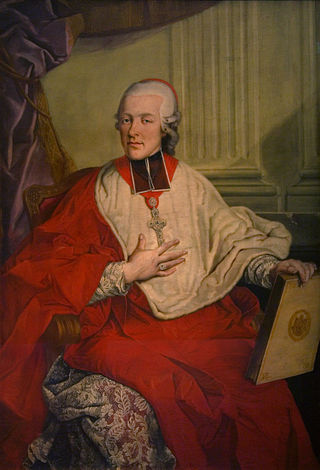Related Research Articles

Eine kleine Nachtmusik, K. 525, is a 1787 composition for a chamber ensemble by Wolfgang Amadeus Mozart (1756–1791). The German title means "a little night music". The work is written for an ensemble of two violins, viola, cello and double bass, but is often performed by string orchestras. The serenade is one of Mozart's most famous works.

Joseph Haydn's Symphony No. 13 in D major was written in 1763 for the orchestra of Haydn's patron, Prince Nikolaus Esterházy, in Eisenstadt.

Symphony No. 35 in D major, K. 385, also known as the Haffner Symphony, was composed by Wolfgang Amadeus Mozart in 1782. It was commissioned by the Haffners, a prominent Salzburg family, for the occasion of the ennoblement of Sigmund Haffner the Younger. The Haffner Symphony should not be confused with the eight-movement Haffner Serenade, another piece Mozart wrote on commission from the same family in 1776.

The Symphony No. 29 in A major, K. 201/186a, was completed by Wolfgang Amadeus Mozart on 6 April 1774. It is, along with Symphony No. 25, one of his better known early symphonies. Stanley Sadie characterizes it as "a landmark ... personal in tone, indeed perhaps more individual in its combination of an intimate, chamber music style with a still fiery and impulsive manner."

Symphony No. 20 in D major, K. 133, was composed by Wolfgang Amadeus Mozart in July 1772, when Mozart was sixteen years old. This symphony is one of many written during the period Mozart stayed in Salzburg, between two trips to Italy. Compared to other symphonies Mozart wrote in this period, the scoring is extravagant, featuring two trumpets in addition to the standard oboes, horns, and strings. The key of D major, which is a key often reserved for ceremonial music, is well suited to the presence of these trumpets.

The Symphony No. 70 in D major, Hoboken 1/70, was written by Joseph Haydn to mark the start of construction of a new opera house on the Eszterháza estate. It was premiered on December 18, 1779—one of the few Haydn symphonies where the exact premiere date is known.

The Serenade No. 10 for winds in B-flat major, K. 361/370a, is a serenade by Wolfgang Amadeus Mozart scored for thirteen instruments: twelve winds and string bass. The piece was probably composed in 1781 or 1782 and is often known by the subtitle Gran Partita, though the title is a misspelling and not in Mozart's hand. It consists of seven movements.
Michael Haydn's Symphony No. 24 in A major, Perger 15, Sherman 24, MH 302, was written in Salzburg in 1781.

The Symphony No. 8 in D major,, by Wolfgang Amadeus Mozart is dated 13 December 1768. Mozart wrote the symphony in Vienna, when he was twelve years old, at a time when he and his family were already due to have returned home to Salzburg. In a letter to his friend in Salzburg, Johann Lorenz Hagenauer, Leopold Mozart says of the delay that "we could not bring our affairs to a conclusion earlier, even though I endeavored strenuously to do so." The autograph of the Symphony No. 8 is today preserved in the Berlin State Library.

The Serenade for Orchestra No. 9 in D major K. 320, Posthorn, was written by Wolfgang Amadeus Mozart in Salzburg, in 1779. The manuscript is dated 3 August 1779 and was intended for the University of Salzburg's "Finalmusik" ceremony that year.

Symphony No. 7 in D major, K. 45, by Wolfgang Amadeus Mozart, was completed in Vienna in January 1768 after the family's return from a visit to Olomouc and Brno in Moravia. The symphony is in four movements. Its first performance was probably at a private concert. The symphony was reworked to become the overture to Mozart's opera, La finta semplice, K. 51, composed and performed later that year, and the overture itself was subsequently adapted further to create a new symphony, known in the Köchel 1964 (K6) catalogue as K. 46a. The autograph of the score is preserved in the Berlin State Library.

Symphony No. 9 in C major, K. 73/75a, by Wolfgang Amadeus Mozart, has an uncertain provenance. The most likely date of its composition appears to be late 1769 or early 1770 during Mozart's first Italian journey, although some authorities have dated it "probably not before early summer 1772". It may have been started in Salzburg, before the first Italian journey began, and completed during the trip.

Wolfgang Amadeus Mozart wrote Symphony No. 30 in D major, K. 202/186b in Salzburg, completing it on 5 May 1774.
The Serenade No. 5 in D major, K. 204/213a was written on 5 August 1775 by Wolfgang Amadeus Mozart for ceremonies at the University of Salzburg. The work is very similar to the serenade K. 203, composed for Salzburg the previous summer.

The Serenade No. 4 in D major, K. 203/189b was written in August 1774 by Wolfgang Amadeus Mozart for ceremonies at the University of Salzburg. It is nicknamed Colloredo after Mozart's patron, Count Hieronymus von Colloredo. The work is very similar to the serenade K. 204 composed for Salzburg the following summer.
The Symphony "No. 43" in F major, K. 76/42a, was probably written by Wolfgang Amadeus Mozart.
Michael Haydn's Serenade in D major, Perger 87, MH 86 was written in Salzburg in 1767.

The Cassation in G major, K. 63 is a cassation for orchestra by Wolfgang Amadeus Mozart, composed around 1769 for the celebration of finalists from the University of Salzburg. The work is one of three smaller-scale compositions, all written in 1769.

The Divertimento No. 1 in E-flat major, K. 113, is the first divertimento by Wolfgang Amadeus Mozart. Composed in late 1771. It was most likely first performed on 22 or 23 November for a subscription concert in Milan.
References
- ↑ Lorenz, Michael (8 April 2013). "Michael Lorenz: A Little Leitgeb Research". Michael Lorenz. Retrieved 25 April 2024.
- 1 2 3 Golding, Robin (1991). A Variety of Forms and Styles: Mozart's Serenades for Orchestra. Germany: Philips Classics Records. pp. 21–22.